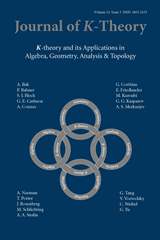Article contents
Invariance de la K-Théorie par équivalences dérivées
Published online by Cambridge University Press: 13 November 2009
Abstract
The aim of these notes is to prove that any right exact functor between reasonable Waldhausen categories, that induces an equivalence at the level of homotopy categories, gives rise to a homotopy equivalence between the corresponding K-theory spectra. This generalizes a well known result of Thomason and Trobaugh. The ingredients, for this proof, are a generalization of the Waldhausen approximation theorem, and a simple combinatorial caracterization of derived equivalences. We also study simplicial localization of Waldhausen categories. We prove that a (homotopy) right exact functor induces an equivalence of homotopy categories if and only if it induces anequivalence of simplicial localizations. This allows to make the link with the K-theory of simplicial categories introduced by Toën and Vezzosi.
Résumé
Ces notes ont pour but de démontrer que tout foncteur exact à droite entre catégories de Waldhausen raisonnables, induisant une équivalence au niveau des catégories homotopiques, définit une équivalence d'homotopie entre les spectres de K-théorie correspondants. Cela généralise un résultat bien connu de Thomason et Trobaugh. Les ingrédients de démonstration sont une généralisation du théorème d'approximation de Waldhausen et une caractérisation combinatoire simple des équivalences dérivées. On étudie par ailleurs la localisation simpliciale des catégories de Waldhausen. On démontre qu'un foncteur (homotopiquement) exact à droite induit une équivalence de catégories homotopiques si et seulement s'il induit une équivalence au niveau des localisations simpliciales. Cela permet de faire le lien avec la K-théorie des catégories simpliciales introduite par Toën et Vezzosi.
- Type
- Research Article
- Information
- Copyright
- Copyright © ISOPP 2009
References
- 20
- Cited by




